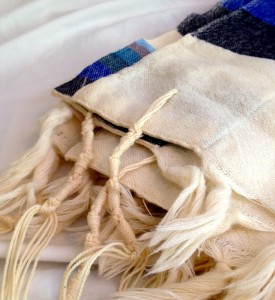I have heard that many couples incorporate a tallit (Jewish prayer shawl) into their wedding. What is the reason for this?
There are two main ways a couple can incorporate a tallit into their Jewish wedding ceremony:
- they can use it as the canopy for the chuppah (marriage canopy)
- the couple can be wrapped in the tallit for a portion of the wedding ceremony
Why do this?
When my daughter was a newborn, my beloved aunt made for her a beautiful baby blanket. The enclosed note read:”May she always be wrapped in love.”
As that small flannel blanket serves, for my daughter, as a reminder of abiding love, another four corned cloth serves, in Jewish tradition, as a reminder of an abiding, loving relationship: the tallit.
A tallit is a four cornered garment, with special knots at each of the four corners called tzitzit. Going back to the Torah, those tzitzit serve as a reminder of the sacred relationship that the Jewish people have with God and Torah. When we look at the tzitzit we are to remember the commandments and traditions of our people. (If you’d like to learn more, Rabbi Amy Scheinerman has a great explanation of tallit.)
Beyond this: if you were to ask someone who wears a tallit, or who remembers sitting next to a beloved grandparent or parent in synagogue who wrapped himself in a tallit, she might well share with you that the act of wearing (in the Hebrew, wrapping oneself) in that tallit helps her feel connected with, surrounded by, even enveloped by the loving protection of the Holy One.
A tallit can thus serve as a reminder of the Jewish home you are creating together. Beyond this, it can be a way to consciously invite the loving Presence of the Source of Life and Love to surround you at the moment of your marriage. To be with you and guide you as you build your life together. Indeed, to help you wrap each other in love.


